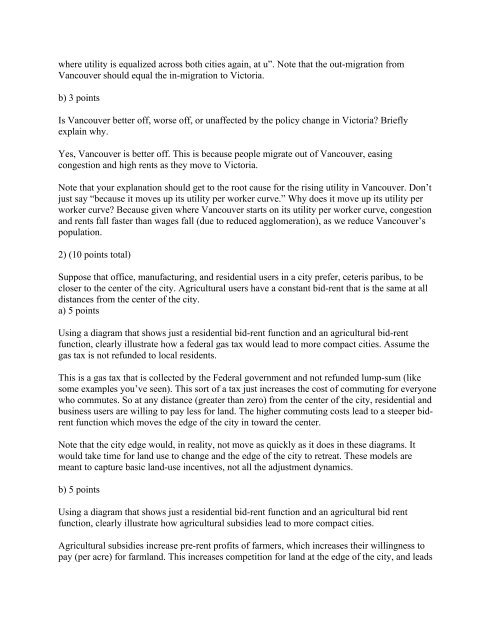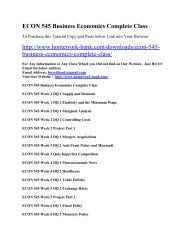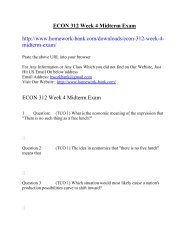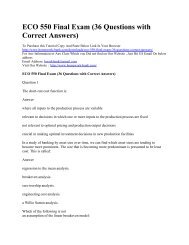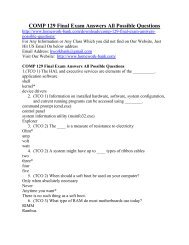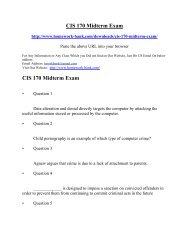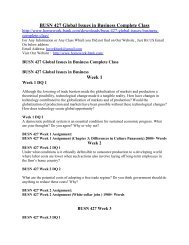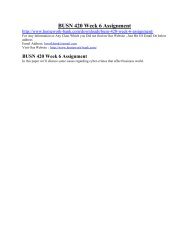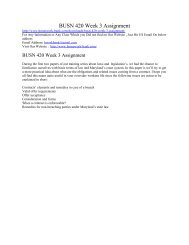o_19i2p1hv3jeu10hr1n4f130kp3d34.pdf
For Any Information or Any Class Which you Did not find on Our Website , Just Hit US Email On below address Email Address: hworkbank@gmail.com Visit Our Website : http://www.homework-bank.com/
For Any Information or Any Class Which you Did not find on Our Website , Just Hit US Email On below address
Email Address: hworkbank@gmail.com
Visit Our Website : http://www.homework-bank.com/
You also want an ePaper? Increase the reach of your titles
YUMPU automatically turns print PDFs into web optimized ePapers that Google loves.
where utility is equalized across both cities again, at u”. Note that the out-migration from<br />
Vancouver should equal the in-migration to Victoria.<br />
b) 3 points<br />
Is Vancouver better off, worse off, or unaffected by the policy change in Victoria? Briefly<br />
explain why.<br />
Yes, Vancouver is better off. This is because people migrate out of Vancouver, easing<br />
congestion and high rents as they move to Victoria.<br />
Note that your explanation should get to the root cause for the rising utility in Vancouver. Don’t<br />
just say “because it moves up its utility per worker curve.” Why does it move up its utility per<br />
worker curve? Because given where Vancouver starts on its utility per worker curve, congestion<br />
and rents fall faster than wages fall (due to reduced agglomeration), as we reduce Vancouver’s<br />
population.<br />
2) (10 points total)<br />
Suppose that office, manufacturing, and residential users in a city prefer, ceteris paribus, to be<br />
closer to the center of the city. Agricultural users have a constant bid-rent that is the same at all<br />
distances from the center of the city.<br />
a) 5 points<br />
Using a diagram that shows just a residential bid-rent function and an agricultural bid-rent<br />
function, clearly illustrate how a federal gas tax would lead to more compact cities. Assume the<br />
gas tax is not refunded to local residents.<br />
This is a gas tax that is collected by the Federal government and not refunded lump-sum (like<br />
some examples you’ve seen). This sort of a tax just increases the cost of commuting for everyone<br />
who commutes. So at any distance (greater than zero) from the center of the city, residential and<br />
business users are willing to pay less for land. The higher commuting costs lead to a steeper bidrent<br />
function which moves the edge of the city in toward the center.<br />
Note that the city edge would, in reality, not move as quickly as it does in these diagrams. It<br />
would take time for land use to change and the edge of the city to retreat. These models are<br />
meant to capture basic land-use incentives, not all the adjustment dynamics.<br />
b) 5 points<br />
Using a diagram that shows just a residential bid-rent function and an agricultural bid rent<br />
function, clearly illustrate how agricultural subsidies lead to more compact cities.<br />
Agricultural subsidies increase pre-rent profits of farmers, which increases their willingness to<br />
pay (per acre) for farmland. This increases competition for land at the edge of the city, and leads


